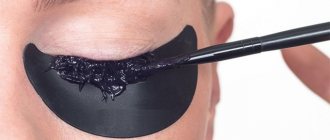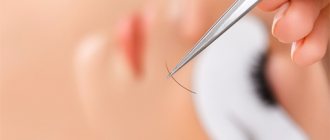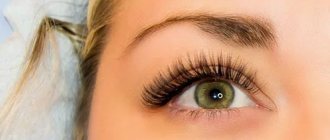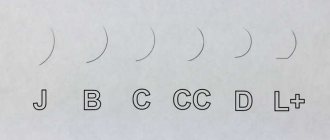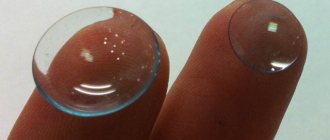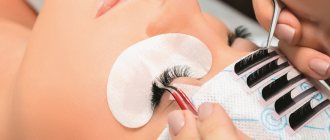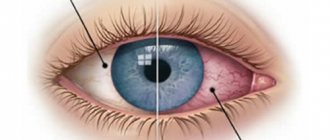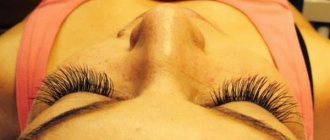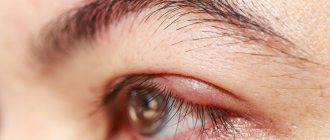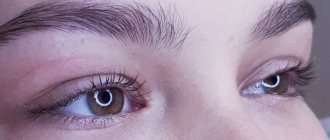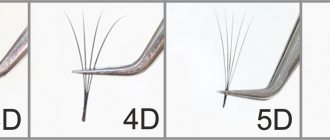01.08.2015
Irregular eyelash growth is called trichiasis. It can be either congenital or acquired. With this disease, the eyelashes grow towards the eyeball, and therefore severe irritation of the cornea occurs. As a result, conjunctivitis and various eye infections often occur. If the disease is not treated for a long time, clouding of the cornea and its erosion may occur.
The main symptoms of the disease include:
- sensation of the presence of a foreign body;
- profuse lacrimation;
- redness of the eye;
- superficial keratitis.
Contact lenses can help protect the cornea from damage.
Eyelash epilation has only a temporary effect. This is due to the fact that the eyelash bulbs remain intact, and eyelashes that grow pathologically again cause discomfort after five to ten weeks.
If the area affected by trichiasis is small, it is possible to use the technique of destroying the follicles using electrolysis.
If the affected area is significant, then surgical intervention is required - eyelid surgery.
There are several types of trichiasis. Classification is carried out according to which area of the eyelids is covered.
- common;
- bilateral;
- unilateral;
- local.
The causes of trichiasis are varied. The congenital disease manifests itself immediately. Acquired trichiasis can appear as a result of traumatic damage to the eyelid or its burns (with acids or alkalis), with scar tissue changes and tumor growth. Also, this disease often manifests itself as a consequence of blepharitis or conjunctivitis, herpes of the organs of vision, and the appearance of trachoma. Entropion is always accompanied by trichiasis. Sometimes the causes of the disease cannot be determined.
If scars have formed on the edge of the eyelid, then displacement of the eyelash follicles or their complete death is possible. As a result of this, the eyelashes either stop growing completely or begin to grow in the wrong position.
Etiology
First of all, it should be noted that scientists have not yet been able to establish the etiology of the congenital form. As for the acquired form of the pathological process, the following etiological factors should be highlighted:
- trachoma;
- cicatricial pemphigoid;
- eyelid defects after surgery;
- improper healing of sutures after surgery;
- chemical or thermal burns of the organs of vision;
- consequences of mechanical damage;
- personal history of acute or chronic blepharitis;
- degenerative changes in the orbital conjunctiva;
- persistent type herpetic infection;
- impaired production of tear fluid;
- inflammation of the lacrimal gland.
There are no third-party pathological processes that can act as an etiological factor for this disease.
Causal factors
The eyelid and eyelashes protect the eye from negative influences (too bright light, dust, dirt, etc.). With trichiasis, eyelashes constantly injure the eye and cause visual disturbances.
The direction of eyelash growth changes due to the deformation of the eyelid. The cavity of the hair follicle, which is located in the eyelid, changes its location, and as a result, the direction of hair growth also changes. As a result of constant friction of the cilia on the cornea, inflammation occurs, which is accompanied by a secondary infection.
Main causes of the disease:
After injury or inflammation, the edges of the eyelids become overgrown with connective tissue, which is why eyelashes are absent or their bulbs are displaced, as a result of which the direction of eyelash growth changes.
Classification
Based on the nature of origin, there are only two possible forms of development of this disease:
- congenital.
- acquired.
Based on the nature of the localization of the pathological process, the following forms are distinguished:
- local;
- diffuse.
As for the area of damage to the organs of vision, most often the pathological process is unilateral; bilateral pathology is practically not diagnosed.
Only a qualified specialist can determine exactly what form of the disease is occurring by carrying out all the necessary diagnostic measures. That is why self-treatment is strongly not recommended. This is fraught with the development of serious complications.
Symptoms
Trichiasis in children and adults is characterized by the following clinical picture:
- constant increased lacrimation.
- increased sensitivity to light stimuli.
- decreased visual acuity.
- redness and swelling of the conjunctiva.
- the formation of erosions on the cornea that do not heal for a long time.
- spasm of accommodation.
- I get a headache when looking at the light.
In addition, due to the increased production of tear fluid, crusts form in the corners of the eyes and on the eyelashes. There is also a cosmetic defect due to the fact that the eyelashes grow inside the eye. No asymptomatic clinical course was observed.
Symptoms
If the eyelash curls up and grows into the tissue of the upper eyelid, it may not cause much discomfort. Upon examination, a small bump is found on the edge of the upper eyelid. Sometimes it can fester with formation. In this case, the tissue of the eyelid swells, becomes painful, and a round red formation is visible on the skin, often with a purulent head.
Sometimes eyelashes grow so that they touch the mucous membrane of the eyelid - the conjunctiva or the cornea lining the surface of the eyeball. These conditions are accompanied by pain, lacrimation, photophobia, and frequent blinking. With constant friction of the eyelash on the cornea, the latter is injured, erosions (superficial damage, “scuffs”) are formed on it, which later become infected. Superficial keratitis occurs - inflammation of the cornea. Its outcome is cloudiness and the formation of a so-called cataract. As a result, vision is impaired and blindness may even develop.
Sometimes, after healing of an eyelid injury, severe scar deformation occurs - eversion, accompanied by widespread trichiasis, that is, the ingrowth of a large number of eyelashes.
Diagnostics
You should consult an ophthalmologist . To begin with, the doctor conducts a visual examination of the patient and finds out the following:
- how long ago the first manifestations began;
- is there a history of burns, injuries to the organs of vision, chronic ophthalmological diseases;
- whether you have had surgery on the affected eye;
- personal and family history is clarified, since a genetic predisposition to such a pathological process cannot be ruled out.
It is not possible to make an accurate diagnosis based on an initial examination alone, so several diagnostic techniques are used, namely:
- visometry.
- biomicroscopy using a slit lamp.
- biomicroscopy with contrast agent.
- analysis of tear fluid.
Due to the fact that the clinical picture may be somewhat ambiguous, differential diagnosis may be necessary regarding the following pathological processes:
- distichiasis (quite common in humans);
- entoprion;
- epiblepharon;
- turning of the eyelids.
Based on the results of the study, the doctor can determine an accurate diagnosis and prescribe the correct treatment. Self-medication, especially through traditional medicine, is excluded.
In this case, this is impractical, since folk remedies do not provide the desired therapeutic effect.
Treatment of ingrown eyelashes in the upper eyelid
Depending on the stage of ingrowth, the development of concomitant symptoms, and the presence of complications, treatment is carried out at home after consultation with an ophthalmologist. In the hospital, medication and minimally invasive correction methods are used or surgical operations are performed.
With a mild stage of ingrowth, it is possible to resolve the problem by styling eyelashes using special oil-based serums. With frequent recurrence and development of inflammation, medical intervention is required.
Removal with tweezers
Treatment
Treatment of trichiasis of the eyelids is carried out only through an integrated approach - the removal of pathology and the use of medications in the postoperative period.
It should be noted that simply removing eyelashes with tweezers is not practical, since due to their rapid growth, the procedure must be repeated every thirty days . This will lead to trauma and inflammation with subsequent ophthalmological diseases.
In order to remove an ingrown eyelash, the following surgical methods are used:
- diathermocoagulation - in this case, eyelash removal is carried out using a special needle-type electrode.
- argon laser coagulation.
- electrolysis.
In addition, traditional surgical intervention can be used - a through resection of the affected eyelid is performed, followed by plastic surgery of the edges and layer-by-layer suturing of the area.
In some cases, cryotherapy with liquid nitrogen can be used, but this method of treatment has its negative consequences - tissue areas may die, which also leads to a cosmetic defect.
As for drug therapy, it is used only after surgery. Your doctor may prescribe the following medications:
- antibacterial;
- antiseptic solutions;
- anti-inflammatory.
It should be noted that almost all drugs are prescribed for topical use only. In some cases, antibiotic therapy may be prescribed to prevent the infectious process.
As a rule, it is recommended for patients to apply antibacterial ointment at night for three days after surgery, but it should be understood that everything depends on the patient’s individual parameters.
Eyelash pulling - how to treat the disease?
Trichotillomania is a pathological condition in which there is an obsessive urge to pull out hair on the head, eyebrows, and eyelashes.
The causes of the obsessive state are disturbances in higher mental activity. Provoking factors:
- stressful situations;
- mental instability;
- schizophrenia;
- psychological and organic trauma.
There is no general treatment method for this pathology. Since each case should be approached individually. The following are used as treatment:
- depilation;
- use of antidepressants and psychotherapy;
- in some cases, hormone therapy;
- massages;
- cryomassage;
- psychological methods of treatment for pulling out.
Without eliminating the stress factor that causes the desire to pull out your hair, any treatment methods for trichotillomania are not effective.
In order for your eyelashes to grow long and healthy, you don’t have to visit beauty salons and spend crazy amounts of money.
Daily care can be budget-friendly:
- Don't torture your natural eyelashes with endless extensions. Glues for attaching hairs are still aggressive chemicals.
- Don't use curling irons all the time. This will make them dull.
- Use only high-quality cosmetics. And in the evening, be sure to remove makeup.
- Periodically nourish your hair with any natural oil - olive, castor, almond. Even good quality sunflower will do.
This is enough to extend the life of hairs, make them thicker, and make your eyes bright and inviting.
Some people's eyelashes curl inward. They can injure the cornea or conjunctiva of the eye. This disease is called trichiasis. It is accompanied by discomfort, and in severe cases, ulcerations appear on the cornea.
Prognosis and possible complications
The prognosis will depend on the timeliness of the start of treatment and the etiological factor that caused the development of such a pathological process.
In general, if you consult a doctor in a timely manner, complications are excluded. However, it should be understood that the root cause must be eliminated first, since relapse cannot be ruled out in any case.
Possible complications include:
- decrease in visual acuity up to its complete loss and disability of a person.
- chronic ophthalmological diseases - most often blepharitis and conjunctivitis.
- inflammation of the lacrimal gland.
- inflammation of the skin around the affected organ of vision.
- constant lacrimation.
The development of such aggravating diseases can be avoided if specific treatment is started in a timely manner.
What does the loss indicate?
Hair loss in the edge of the eyelid is a normal situation if up to 5 hairs are lost per day. New ones will grow quickly. If more eyelashes are lost, this may indicate a number of pathological changes in the body.
Why do eyelashes fall out?
- Wearing eyelash extensions for a long time.
- Stress and poor nutrition, lack of vitamins and minerals, use of extreme diets.
- Hormonal imbalance.
- Taking certain medications on an ongoing basis.
- Inflammatory processes in the tissues of the visual analyzer.
If you notice that your eyelashes have begun to fall out or any system-wide symptoms have appeared, you should undergo a comprehensive examination.
Prevention
Regarding this disease, preventive recommendations regarding etiological factors should be followed. In addition, you must follow the general rules:
- visual hygiene;
- proper use of contact lenses;
- timely treatment of all infectious and inflammatory diseases;
- strengthening the immune system.
You should also remember that self-medication can lead to complications, therefore, when the first clinical signs appear, you should seek help from a qualified specialist. You regularly need to undergo a preventive examination by an ophthalmologist.
